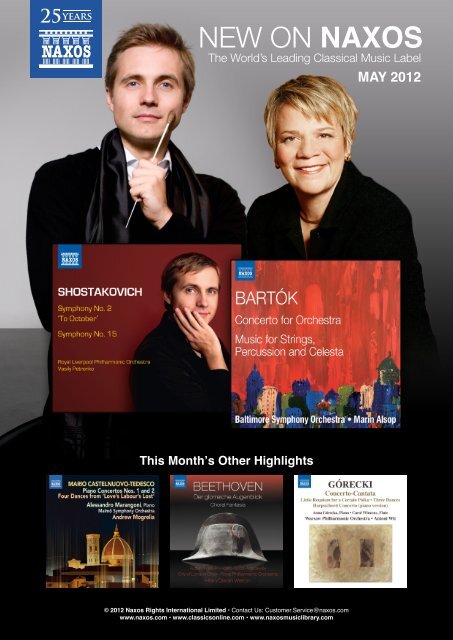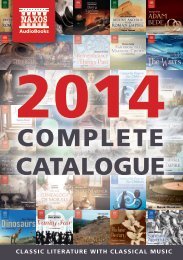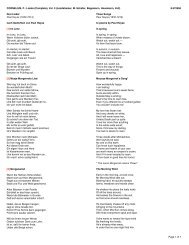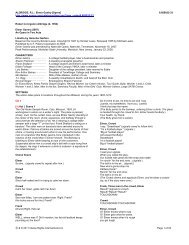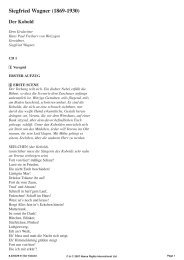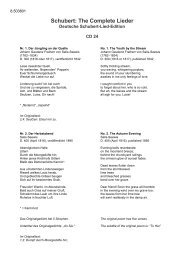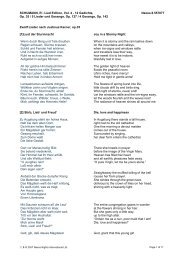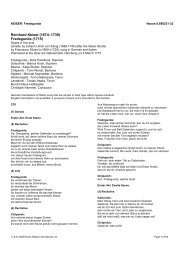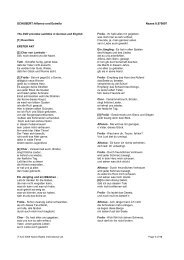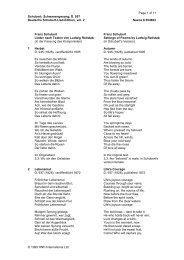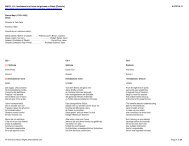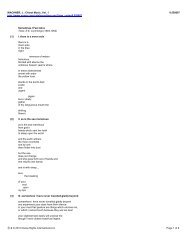You also want an ePaper? Increase the reach of your titles
YUMPU automatically turns print PDFs into web optimized ePapers that Google loves.
25 years<br />
<strong>New</strong> <strong>oN</strong> <strong>NAxOs</strong><br />
The world’s Leading Classical Music Label<br />
This Month’s Other Highlights<br />
© 2012 Naxos Rights International Limited • Contact Us: Customer.Service@naxos.com<br />
www.naxos.com • www.classicsonline.com • www.naxosmusiclibrary.com<br />
MAY 2012
© Zu Zweit © Bruna Rausa<br />
© Matthew Washburn<br />
Alessandro Marangoni<br />
Andrew Mogrelia<br />
2<br />
<strong>New</strong> ON <strong>NAxOs</strong> | MAY 2012<br />
8.572823 Playing Time: 76:43<br />
7 47313 28237 1<br />
Mario CASTELNUOVO-TEDESCO (1895-1968)<br />
Piano Concerto No 1 in G minor, Op 46<br />
Piano Concerto No 2 in F major, Op 92<br />
Four Dances from ‘Love’s Labour’s Lost’, Op 167*<br />
Alessandro Marangoni, piano<br />
Malmö Symphony Orchestra • Andrew Mogrelia<br />
* First Performance and Recording<br />
Mario Castelnuovo-Tedesco’s two Piano Concertos form a contrasting<br />
pair. Concerto No. 1, written in 1927, is a vivid and witty example of his<br />
romantic spirit, exquisite melodies and rich yet transparent orchestration.<br />
Concerto No. 2, composed a decade later, is a darker, more dramatic<br />
and virtuosic work. The deeply-felt and dreamlike slow movement and<br />
passionate finale are tinged with bleak moments of somber agitation,<br />
suggestive of unfolding tragic events with the imminent introduction of<br />
the Fascist Racial Laws that led Castelnuovo-Tedesco to seek exile in<br />
the USA in 1939. The Four Dances from ‘Love’s Labour’s Lost’, part<br />
of the composer’s recurring fascination for the art of Shakespeare, are<br />
atmospheric, richly characterised and hugely enjoyable. This is their first<br />
performance and recording.<br />
After winning national and international awards, Alessandro Marangoni<br />
has appeared throughout Europe and America, as a soloist and as a<br />
chamber musician, collaborating with some of Italy’s leading performers.<br />
In 2007 he won the prestigious Amici di Milano International Prize for<br />
Music. Andrew Mogrelia has had a varied career of concerts, recording<br />
and work with major dance companies. He has an extensive discography<br />
for Naxos/Marco Polo, with his complete Sleeping Beauty (8.550490-92)<br />
acclaimed as a ʻclear first choiceʼ by Gramophone magazine.<br />
Companion Titles<br />
CASTELNUOVO-TEDESCO Shakespeare Overtures, Vol 1 8.572500<br />
CASTELNUOVO-TEDESCO Shakespeare Overtures, Vol 2 8.572501<br />
FERRARA Fantasia tragica, Notte di tempesta, Burlesca 8.572410<br />
MALIPIERO Impressioni dal vero, Pause del silenzio 8.572409
8.572486 Playing Time: 67:27<br />
7 47313 24867 4<br />
Béla BARTÓK (1881-1945)<br />
Concerto for Orchestra<br />
Music for Strings, Percussion and Celesta<br />
Baltimore Symphony Orchestra • Marin Alsop<br />
Béla Bartók’s Concerto for Orchestra, one of his greatest works, was<br />
written in the United States after the composer was forced to flee<br />
Hungary during World War II. It is not only a brilliant display vehicle for<br />
each instrumental section but a work of considerable structural ingenuity<br />
that unites classical forms and sonorities with the pungency of folk<br />
rhythms and harmonies. Music for Strings, Percussion and Celesta<br />
explores darker moods through a score of marvellously poised symmetry.<br />
This release follows Marin Alsop’s ‘riveting’ (Gramophone) Baltimore<br />
Symphony recordings of Dvořák’s symphonies.<br />
Marin Alsop made history with her appointment as the twelfth music<br />
director of the Baltimore Symphony Orchestra. With her inaugural<br />
concerts in September 2007, she became the first woman to head a<br />
major American orchestra. Her most recent appointment as principal<br />
conductor of the Sao Paulo State Symphony Orchestra (OSESP),<br />
starting in 2012, marks another historic appointment for her. In 2005,<br />
Marin Alsop was named a MacArthur Fellow, the first conductor ever to<br />
receive this prestigious award.<br />
Companion Titles<br />
8.557433 8.660928 8.559325 8.669022-24<br />
3<br />
<strong>New</strong> ON <strong>NAxOs</strong> | MAY 2012<br />
Marin Alsop<br />
© Kym Thomson<br />
© Dave Harp
© Juliusz Multarzynski<br />
Antoni Wit<br />
4<br />
<strong>New</strong> ON <strong>NAxOs</strong> | MAY 2012<br />
8.572872 Playing Time: 69:33<br />
7 47313 28727 7<br />
Henryk GÓRECKI (1933-2010)<br />
Concerto-Cantata, Op 65<br />
† * World Première Recording<br />
Little Requiem for a Certain Polka, Op 66* • Three Dances, Op 34<br />
Harpsichord Concerto, Op 40 (version for piano and orchestra)*<br />
Anna Górecka, piano* • Carol Wincenc, flute †<br />
Warsaw Philharmonic Orchestra • Antoni Wit<br />
These four works, written between 1973 and 1993, fully reflect Górecki’s<br />
expressive variety. The Little Requiem for a Certain Polka, for piano and<br />
thirteen instruments, combines a wide range of moods. The Concerto-<br />
Cantata, which received its world première from the soloist on this<br />
recording, alternates a moving vein of melancholy with a charged, violent<br />
energy. The radical, energetic Harpsichord Concerto is heard here in the<br />
version for piano, performed by the composer’s daughter. The Three<br />
Dances are hugely approachable and full of exciting contrast.<br />
Antoni Wit, one of the most highly regarded Polish conductors, studied<br />
conducting with Henryk Czyz and composition with Krzysztof Penderecki<br />
at the Academy of Music in Kraków, subsequently continuing his studies<br />
with Nadia Boulanger in Paris. In 2002 he became managing and artistic<br />
director of the Warsaw Philharmonic Orchestra.<br />
Companion Titles<br />
8.554491 8.570722 8.572487 8.572639
8.572708 Playing Time: 67:03<br />
7 47313 27087 3<br />
Dmitry SHOSTAKOVICH (1906-1975)<br />
Symphony No 2 in B major ‘To October’, Op 14*<br />
Symphony No 15 in A major, Op 141<br />
Royal Liverpool Philharmonic Choir* and Orchestra • Vasily Petrenko<br />
These two hugely contrasting symphonies come from the opposite ends<br />
of Shostakovich’s life and career. The Second Symphony was written to<br />
commemorate the 10th anniversary of the Bolshevik October Revolution. Its<br />
advanced idiom of experimental textures and abstract effects can perhaps be<br />
best described as organised musical chaos. The Fifteenth was Shostakovich’s<br />
last symphony and is filled with remarkable contrasts, from the rollicking<br />
quotes from Rossini’s William Tell Overture and eerie references to Wagner’s<br />
Götterdämmerung and Tristan und Isolde, to the last and perhaps most<br />
imaginative of the composer’s symphonic passacaglias.<br />
Vasily Petrenko became Chief Conductor of the Royal Liverpool Philharmonic<br />
Orchestra in September 2009, and in 2013 will become Chief Conductor of the<br />
Oslo Philharmonic Orchestra. He was the Classical BRIT Awards Male Artist of<br />
the Year 2010 and the Classic FM/Gramophone Young Artist of the Year 2007.<br />
In 2009 he was awarded Honorary Doctorates by the University of Liverpool and<br />
Liverpool Hope University.<br />
Companion Titles<br />
5<br />
<strong>New</strong> ON <strong>NAxOs</strong> | MAY 2012<br />
Vasily Petrenko<br />
8.572082 8.572167 8.572392 8.572461 8.572396 8.572658<br />
© Mark McNulty
8.572062 Playing Time: 66:59<br />
7 47313 20627 8<br />
The Kungsbacka Trio:<br />
Jesper Svedberg (cello), Malin Broman (violin) and<br />
Simon Crawford-Phillips (piano<br />
6<br />
<strong>New</strong> ON <strong>NAxOs</strong> | MAY 2012<br />
Franz Joseph HAYDN (1732-1809)<br />
Piano Trios, Vol 2<br />
Kungsbacka Piano Trio<br />
Repertoire<br />
Trio in E flat major, Hob.XV:30 • Trio in C major, Hob.XV:27<br />
Trio in E major, Hob.XV:28 • Trio in E flat major, Hob.XV:29<br />
Haydn’s Keyboard Trios possess a rich variety of themes and musical<br />
inventiveness, with strong demands on the pianist. The C major is<br />
dramatic and eventful. Patterns are varied in the E major where Haydn<br />
gives the violin major lyrical statements, whilst in the E flat major he uses<br />
all his wit and guile to launch the finale’s captivating and joyful dance<br />
finale. The E flat major Hob. XV: 30 is notable for is subtle thematic<br />
development and commanding drama. Volume 1 (8.572040) of this series<br />
has been greatly admired, not least by Gramophone which stated that<br />
the Kungsbacka Piano Trio had nothing to fear from any other account.<br />
The Kungsbacka Trio takes its name from the Swedish town in which<br />
it gave its first performance and where it has established an annual<br />
festival. Winner of First Prize in the Melbourne International Chamber<br />
Music Competition, it has since appeared at numerous festivals and<br />
venues throughout Europe, North and South America, Australia and<br />
<strong>New</strong> Zealand.<br />
Companion Titles<br />
8.572040 8.572585 8.570518 8.570519<br />
© Hanya Chlala
© Clive Barda<br />
© Robert Taylor<br />
8.572783 Playing Time: 57:41<br />
7 47313 27837 4<br />
7<br />
<strong>New</strong> ON <strong>NAxOs</strong> | MAY 2012<br />
Ludwig van BEETHOVEN (1770-1827)<br />
Der glorreiche Augenblick, Op 136 †<br />
Choral Fantasia, Op 80*<br />
Claire Rutter, soprano • Matilde Wallevik, mezzo-soprano<br />
Peter Hoare, tenor • Stephen Gadd, baritone<br />
Marta Fontannais-Simmons, mezzo-soprano* • Julian Davies, tenor*<br />
Leon McCawley, piano* • Boys of Westminster Under School Senior Choir †<br />
City of London Choir • Royal Philharmonic Orchestra • Hilary Davan Wetton<br />
Beethoven’s unusual cantata Der glorreiche Augenblick (The Glorious<br />
Moment) is filled with patriotic praise for Vienna and tributes to the kings<br />
and princes of Europe after the defeat of Napoleon. It was performed<br />
alongside his symphonic Wellington’s Victory at its première in 1814.<br />
The Fantasia in C minor for piano, chorus and orchestra opens with a<br />
virtuosic, improvisatory Adagio for the piano. The work’s main theme<br />
anticipates the famous Ode to Joy setting Beethoven later devised for<br />
his Choral Symphony.<br />
Artistic Director and Principal Conductor of the City of London Choir<br />
since 1989, Hilary Davan Wetton was founder/conductor of the Holst<br />
Singers and is Conductor Emeritus of the Guildford Choral Society and<br />
the Milton Keynes City Orchestra. He appears regularly on BBC Radio 3<br />
and Classic FM, for which he presented the popular series Masterclass.<br />
Acknowledged as one of Britain’s most prestigious orchestras, the Royal<br />
Philharmonic Orchestra enjoys an international reputation for bringing<br />
audiences worldwide first-class performances and the highest possible<br />
standards of music-making across a diverse range of musical repertoire.<br />
Companion Titles<br />
8.570439 8.572102<br />
Hilary Davan Wetton
8.572892 Playing Time:<br />
66:30<br />
7 47313 28927 1<br />
7 47313 25487 3<br />
World Première<br />
Recordings<br />
8.572548 Playing Time:<br />
66:49<br />
8<br />
<strong>New</strong> <strong>oN</strong> Naxos | MAY 2012<br />
Fernando LOPES-GRAÇA (1908-1993)<br />
Symphony for Orchestra • Suite Rústica No 1<br />
December Poem • Festival March<br />
Royal Scottish National Orchestra • Álvaro Cassuto<br />
Fernando Lopes-Graça was one of the most prolific Portuguese composers of<br />
the 20th century. His use of Portuguese folk-music to forge a personal style is<br />
represented in the Suite Rústica No. 1. More sombre moods are expressed in the<br />
dark atmosphere of December Poem, which contrasts with the extrovert Festival<br />
March. Neo-classical in its extended structures and thematic development,<br />
Lopes-Graça’s award-winning Symphony maintains an unmistakable connection<br />
with the colours and textures of his nation to create music of great expressive<br />
and dramatic depth.<br />
Álvaro Cassuto is Portugal’s foremost conductor. A recipient of the<br />
Koussevitzky Prize among many other honours, he has enjoyed a<br />
career of high international acclaim. He has been a frequent guest of<br />
many leading orchestras, including the London Symphony, the Royal<br />
Philharmonic, the London Philharmonic, the Philadelphia Orchestra, and dozens<br />
of others across the world.<br />
Companion Titles<br />
FREITAS BRANCO Symphony No 1 8.570765<br />
FREITAS BRANCO Symphony No 2 8.572059<br />
BRAGA SANTOS Alfama, Symphonic Overture, Elegy 8.572815<br />
BRAGA SANTOS Symphonies Nos 1 and 5 Marco Polo 8.223879<br />
BRAGA SANTOS Symphony No 4 Marco Polo 8.225233<br />
Eugene ZÁDOR (1894-1977)<br />
Five Contrasts<br />
A Children’s Symphony • Aria and Allegro<br />
Hungarian Capriccio • Csárdás Rhapsody<br />
Budapest Symphony Orchestra MÁV • Mariusz Smolij<br />
Eugene Zádor was a remarkable colourist and orchestrator whose Hollywood film<br />
work was extensive. He described himself as a ‘middle of the road extremist’. The<br />
Aria and Allegro is a beautifully crafted work brimming with rhythmic energy. Five<br />
Contrasts for Orchestra demonstrates his rich sound world at its most vibrant; film<br />
noir jostling with a big-booted country dance. The lighter A Children’s Symphony<br />
is one of his most popular pieces – communicative, witty, accessible. We also<br />
hear two small and captivating evocations of his native Hungary.<br />
Mariusz Smolij is a founding member of the Penderecki String<br />
Quartet, former artistic director of the Lutosławski Wrocław<br />
Philharmonic and International Festival Wratislavia Cantans,<br />
Poland, and currently serves as Music Director of the Acadiana<br />
Symphony in Louisiana and Riverside Symphonia in <strong>New</strong> Jersey.<br />
Companion Titles<br />
RÓZSA Violin Concerto, Sinfonia Concertante 8.570350<br />
RÓZSA Viola Concerto, Hungarian Serenade 8.570925<br />
RÓZSA Three Hungarian Sketches, Cello Rhapsody 8.572285<br />
Hungarian Music for Cello and Piano 8.570570
8.570927 Playing Time:<br />
53:36<br />
7 47313 09277 2<br />
8.572801 Playing Time:<br />
63:28<br />
7 47313 28017 9<br />
9<br />
<strong>New</strong> <strong>oN</strong> Naxos | MAY 2012<br />
Simon MAYR (1763-1845)<br />
Concerto in D minor, ‘Concerto bergamasco’*<br />
Keyboard Concerto in C major †<br />
Trio Concertante in A minor #<br />
Natalie Schwaabe, flute/piccolo* • Andrea Steinberg, clarinet/basset horn*<br />
Antonio Spiller, Yi Li & David van Dijk, violins #<br />
Bavarian Classical Players • Franz Hauk, harpsichord † & conductor<br />
Though revered as ‘the father of Italian opera’, Simon Mayr also wrote largescale<br />
instrumental and orchestral music. His 1820 Concerto in D minor has<br />
an ingenious trick up its sleeve: it introduces each of the four soloists in turn<br />
with the flute, for example, soloing in the first movement and the clarinet in the<br />
second. This elegant, lyrical work hints at Beethoven but also at folklore in a<br />
winning way. The assured Keyboard Concerto reveals the influence of Haydn on<br />
the German-born Mayr whilst the Trio Concertante is imbued with Mayr’s vivid<br />
operatic impulses.<br />
Since 1982 Franz Hauk has served as organist, and since 1995 as choirmaster,<br />
at the Cathedral in Münster. Since 2002 he has taught historical performance<br />
practice and church music at the Munich State Hochschule für Musik und Theater<br />
in München. He has done much to foster a revival of interest in the composer<br />
Johann Simon Mayr.<br />
Companion Titles<br />
MAYR L’Armonia, Cantata for the Death of Beethoven 8.557958<br />
MAYR David in the Cave of Engedi (Oratorio) 8.570366-67<br />
MAYR The Marriage of Tobias (Oratorio) 8.570752-53<br />
MAYR L’amor coniugale 8.660198-99<br />
Reinhard SCHWARZ-SCHILLING (1904-1985)<br />
Partita • Polonaise • Violin Concerto †<br />
Kirill Troussov, violin † • Staatskapelle Weimar • José Serebrier<br />
The so-called ‘lost generation’ of German composers includes many whose lives<br />
were shaped by events after 1933. One such was Reinhard Schwarz-Schilling,<br />
a composer of strong spiritual depth whose 1953 Violin Concerto was rooted in<br />
his wartime experiences. Ingeniously constructed, it subtly evokes the influence<br />
of Bach, without at all embracing neo-classicism. Its moving slow movement is<br />
followed by a finale that marries virtuosity with dance-like magnetism. The Partita<br />
is much admired for its colour and vitality, whilst the Polonaise is a lighter work,<br />
brimming with high spirits.<br />
GRAMMY ® -winner conductor and composer José Serebrier is one of<br />
today’s most recorded classical artists. He has received 39 GRAMMY ®<br />
nominations in recent years. His First Symphony (8.559648) was<br />
premièred by Leopold Stokowski (who premièred several of his works)<br />
when Serebrier was 17, as a last-minute replacement for the then still unplayable<br />
Ives Fourth Symphony.<br />
Companion Title<br />
SCHWARZ-SCHILLING Sinfonia diatonica, Symphony in C 8.570435
8.572827 Playing Time:<br />
74:48<br />
7 47313 28277 7<br />
8.572349 Playing Time:<br />
76:40<br />
7 47313 23497 4<br />
10<br />
<strong>New</strong> <strong>oN</strong> Naxos | MAY 2012<br />
NORDIC VIOLIN FAVOURITES<br />
Henning Kraggerud, violin • Dalasinfoniettan • Bjarte Engeset<br />
Repertoire<br />
Carl Gustav Sparre OLSEN (1903-1984) • Six Old Village Songs from Lom in Norway<br />
Kurt ATTERBERG (1887-1974)<br />
World Première Recording<br />
Suite No 3 for violin, viola and string orchestra, Op 19 (version for two violins and strings)<br />
Wilhelm STENHAMMAR (1871-1927) • Two Sentimental Romances for violin and orchestra, Op 28<br />
Ole Bornemann BULL (1810-1880)<br />
Los Recuerdos de la Habana (Memories of Havana) • A Mountain Vision (version for violin and strings)<br />
Johan HALVORSEN (1864-1935) • Norwegian Dance No 3 for violin and orchestra<br />
Jean SIBELIUS (1865-1957) • Six Humoresques for violin and orchestra, Opp 87 & 89<br />
Christian SINDING (1856-1941) • Evening Mood, Op 120<br />
There was a particularly rich vein of Nordic writing for the violin between the years<br />
1910 and 1930. In this recital Henning Kraggerud, an exemplary stylist lauded for<br />
his Sibelius and Sinding concerto disc, Naxos 8.557266 (CD) and 6.110056 (SACD)<br />
(‘Kraggerud’s performance is superb throughout’ – Classics Today.com), explores<br />
this memorable repertoire. It ranges from Halvorsen’s folk-flecked Norwegian<br />
Dance to Stenhammar’s passionate Sentimental Romances. Late romanticism<br />
floods Sinding’s Abendstimmung whilst Sibelius’s Six Humoresques remain a<br />
masterpiece of the genre. The earlier works of Ole Bull illustrate the brilliance and<br />
panache of ‘The Nordic Paganini’.<br />
Henning Kraggerud is a recipient of Norway’s prestigious Grieg Prize,<br />
the Ole Bull Prize and the Sibelius Prize. He is a professor at the Barratt<br />
Due Institute of Music in Oslo, and appears as a soloist with many of the<br />
world’s leading orchestras.<br />
Companion Titles<br />
Norwegian Violin Favourites 8.554497<br />
SIBELIUS Violin Concerto / SINDING Violin Concerto No 1 8.557266<br />
SINDING Music for Violin and Piano, Vol 1 8.572254<br />
SINDING Music for Violin and Piano, Vol 2 8.572255<br />
Peter MAXWELL DAVIES (b 1934)<br />
Symphony No 2 • St Thomas Wake<br />
BBC Philharmonic • Peter Maxwell Davies<br />
Sir Peter Maxwell Davies’ Second Symphony is his ‘Sea Symphony’, a complex,<br />
virtuosic work that explores in absorbing, increasingly dynamic fashion, the<br />
ocean’s proximity and what the composer calls ‘the architecture of its forms’.<br />
Both themes and orchestration are masterly. The percussion section is richly<br />
voiced, adding considerably to the symphony’s very particular, rugged and varied<br />
sound world. St Thomas Wake, by contrast, is a disquieting but bravura exercise<br />
in parody, evoking memories of the composer’s experiences during the Second<br />
World War.<br />
Universally acknowledged as one of the foremost composers of our<br />
time, Sir Peter Maxwell Davies has made a significant contribution<br />
to musical history through his wide-ranging and prolific output. He<br />
lives in the Orkney Islands off the north coast of Scotland, where he<br />
writes most of his music.<br />
Companion Titles<br />
MAXWELL DAVIES Symphony No 1, Mavis in Las Vegas 8.572348<br />
MAXWELL DAVIES Naxos Quartets Nos 5 and 6 8.557398<br />
MAXWELL DAVIES Naxos Quartets Nos 7 and 8 8.557399<br />
MAXWELL DAVIES Naxos Quartets Nos 9 and 10 8.557400
8.572163 Playing Time:<br />
64:39<br />
7 47313 21637 6<br />
8.572484 Playing Time:<br />
78:43<br />
7 47313 24847 6<br />
11<br />
<strong>New</strong> <strong>oN</strong> Naxos | MAY 2012<br />
Paul HINDEMITH (1895-1963) • String Quartets, Vol 1<br />
String Quartet No 2 in F minor, Op 10<br />
String Quartet No 3 in C major, Op 16<br />
Amar Quartet<br />
Paul Hindemith wrote seven String Quartets, all of which reflect the experience<br />
and practical assurance of a distinguished violinist and, later, violist. No. 2 was<br />
written in 1918 whilst he was a soldier on active duty. It’s a bracing, dynamic and<br />
pithy work with a clever series of variations which parody romantic excess, and a<br />
virtuosic finale. No. 3 followed early in 1920 and was an instant success, a thrilling<br />
example of Hindemith’s concise imagination at work. This passionate quartet,<br />
with its richly varied material, is one of his supreme chamber masterpieces.<br />
In 1922 Paul Hindemith founded a quartet<br />
named after its principal violinist Licco Amar.<br />
On the occasion of Hindemith’s 100th birthday<br />
in 1995, the Hindemith Institute awarded the<br />
Zürich-based ensemble the historic name of<br />
the Amar Quartet, the members of which are<br />
Anna Brunner and Igor Keller (violins), Hannes<br />
Bärtschi (viola), and Péter Somodari (cello).<br />
Companion Titles<br />
HINDEMITH Mathis der Maler Symphony 8.553078<br />
HINDEMITH Clarinet Quintet, Clarinet Quartet 8.572213<br />
20th Century Wind Quintets 8.553851<br />
20th Century Piano Sonatas 8.570401<br />
Camillo SIVORI (1815-1894)<br />
12 Études-Caprices, Op 25<br />
La Génoise – 1er Caprice* • Folies espagnoles, Op 29*<br />
Fulvio Luciani, violin • Massimiliano Motterle, piano*<br />
Camillo Sivori was Paganini’s only acknowledged pupil, and a musician in his<br />
master’s mould, a virtuoso of incredible brilliance. He was also a composer<br />
of distinction. His Caprice-Studies are superbly realised examples of grace,<br />
lyricism and exceptional digital difficulty drawing on the resources of a prodigious<br />
technique. La Génoise consists of a theme and seven variations with violin<br />
and piano equal partners in a breathtaking display of brio and bravura. Folies<br />
espagnoles is a descriptive marvel, a parade of narrative ‘engravings’ that<br />
summon up Spanish sights and sounds.<br />
A pupil of Paolo Borciani, first violin of the Quartetto Italiano, Fulvio<br />
Luciani is the founder and first violin of the Quartetto Borciani. In<br />
many ways a loner, always unconventional in his approach to his<br />
music-making, he is the first ever to have performed Sivoriʼs Twelve<br />
Caprice-Studies; Ricordi have published his edition of the work.<br />
Companion Titles<br />
SAURET Music for Violin and Piano 8.572366<br />
HALVORSEN Sarabande, Passacaglia 8.572522
8.572600 Playing Time:<br />
60:45<br />
7 47313 26007 2<br />
8.572760 Playing Time:<br />
61:11<br />
7 47313 27607 3<br />
12<br />
<strong>New</strong> <strong>oN</strong> Naxos | MAY 2012<br />
The English Song Series • 22<br />
Benjamin BRITTEN (1913-1976)<br />
Songs and Proverbs of William Blake, Op 74<br />
Tit for Tat • Folk-songs<br />
Roderick Williams, baritone • Iain Burnside, piano<br />
Britten wrote his Songs and Proverbs of William Blake, Op. 74 for the German<br />
baritone Dietrich Fischer-Dieskau in 1965. The singer admired the ‘concentration<br />
and enigmatic smile’ of the settings, and Britten constructed, through alternation<br />
of proverbs with songs, and an intense contemplation on the human and the<br />
eternal, one of his greatest song cycles. By contrast Tit for Tat sees Britten<br />
revisiting youthful, light-spirited settings of the poet Walter de la Mare. The folksong<br />
arrangements are amongst his most famous, and beloved.<br />
Roderick Williams Iain Burnside<br />
The baritone Roderick Williams encompasses a wide<br />
repertoire, from baroque to contemporary music, in the<br />
opera house, on the concert platform and in recital. His<br />
recital appearances have taken him to London’s Wigmore<br />
Hall and many European festivals. He has an extensive<br />
discography and his recordings of English song with Iain<br />
Burnside have received particular acclaim.<br />
Companion Titles<br />
VAUGHAN WILLIAMS Songs of Travel 8.557643<br />
FINZI Earth and Air and Rain 8.557963<br />
IRELAND Songs 8.570467<br />
BUTTERWORTH Songs from A Shropshire Lad 8.572426<br />
ALL SHALL BE WELL<br />
Exultate Singers • David Ogden, conductor • Richard May, cello*<br />
Rebecca Quiney, Soprano † • Oliver Condy, Tenor †<br />
World Première Recording<br />
Repertoire • Roxanna PANUFNIK (b.1968) All Shall Be Well*<br />
G HOLST Nunc dimittis † • R VAUGHAN WILLIAMS Valiant-for-Truth<br />
S RACHMANINOV Bogoroditsye Dyevo • J TAVENER Svyati* • H GÓRECKI Totus<br />
Tuus • Jaakko MÄNTYJARVI O magnum mysterium • Pierre VILLETTE Hymne à<br />
la Vierge • Knut NYSTEDT Stabat Mater*<br />
This wide-ranging programme offers connections and contrasts in music of devotion<br />
and consolation. The settings by life-long friends Holst and Vaughan Williams,<br />
whilst very different, are highly affecting. The music of Rachmaninov, whose hymn<br />
derives from his 1915 All-Night Vigil, and John Tavener is immersed in the ritual<br />
of the Russian Orthodox Church. Marian Prayers come from Pierre Villette and<br />
Knut Nystedt. The music that gives its name to the title of the disc is the beautiful<br />
‘conversation’ of Roxanna Panufnik.<br />
Founded by conductor and composer David Ogden in<br />
2002 to sing a live broadcast on BBC Radio, Exultate<br />
Singers has gone on to give over 120 concerts,<br />
broadcasts and other appearances in the United<br />
Kingdom, Poland, the Czech Republic, Germany and<br />
Spain. The choir has given several broadcasts on BBC<br />
Radio and has appeared on BBC television’s Songs of Praise and The One Show.<br />
Companion Titles<br />
RACHMANINOV Vespers 8.555908<br />
TAVENER Ex Maria Virgine 8.572168<br />
VAUGHAN WILLIAMS Sancta Civitas, Dona Nobis Pacem 8.572424<br />
Great British Anthems 8.572504
8.572835<br />
Playing Time: 60:47<br />
7 47313 28357 6<br />
8.572812<br />
Playing Time: 73:58<br />
7 47313 28127 5<br />
8.572682<br />
Playing Time: 62:27<br />
7 47313 26827 6<br />
FEVER PITCH<br />
String Fever • Marin Alsop, leader<br />
Joaquín TURINA (1882-1949) • Piano Music, Vol 8<br />
Jordi Masó, piano<br />
13<br />
<strong>New</strong> <strong>oN</strong> Naxos | MAY 2012<br />
Tracklist • Fever Pitch • Bone Meal • South Street Strut • Go For It • Bubba Loomis Blooz • Who, Me Worry?<br />
In A Monday Mood • Sneakin’ • Caribbean Leprechaun • S.F.O. • Pictures Of Emily • Groovy Cats • Mill Town<br />
Gypsy Ball Mine All Mine<br />
Marin Alsop<br />
Founded by Marin Alsop in 1981, String Fever was hailed for its remarkable versatility and<br />
unique blend of pop, jazz and classical repertoire. Fever Pitch presents pieces written and<br />
arranged for String Fever by a quartet of leading composers whose origins range from<br />
1920s vaudeville to big band, film music and American and Afro-Caribbean folk. Marin<br />
Alsop performs numerous solos in a kaleidoscopic program which follows on from the swing<br />
standards of It Don’t Mean A Thing (8.572834).<br />
Much in demand by many top solo artists from Billy Joel to the late Sir Yehudi Menuhin, String Fever is<br />
featured on two of Billy Joel’s albums, Nylon Curtain and Innocent Man.<br />
I SAW ETERNITY<br />
Michael Bloss, organ* • Leslie De’Ath, piano † • John Marshman, cello # • Stephen Pierre, clarinet #<br />
Elora Festival Singers • Noel Edison<br />
Repertoire • Timothy CORLIS Gloria † • Leonard ENNS I saw eternity • Peter TIEFENBACH Nunc Dimittis • Ruth<br />
WATSON HENDERSON Missa Brevis • T CORLIS To See the Cherry Hung With Snow • Paul HALLEY Bring Us,<br />
O Lord God* • Craig GALBRAITH Let All Mortal Flesh Keep Silence • Marjan MOZETICH Flying Swans # • Mark<br />
G SIRETT Bless the Lord for the Good Land • Glenn BUHR Agnus Dei • Imant RAMINSH Psalm 23 • Stephen<br />
CHATMAN Remember<br />
Noel Edison<br />
Companion Title<br />
It Don’t Mean A Thing 8.572834<br />
This recording brings together eleven leading composers whose origins in or strong<br />
associations with Canada are manifest in their central position in Canadian musical life.<br />
In a programme through which the power of tradition and faith flows strongly, themes are<br />
explored ranging from paradise and heavenly fulfilment to tragic loss; and from timeless<br />
hymn and psalm texts to an exploration of the brevity of human existence in the title work,<br />
I Saw Eternity. One of the finest chamber choirs in Canada and beyond, the Elora Festival<br />
Singers’ ‘must-have’ (Gramophone) programme of Eric Whitacre (8.559677) is just one of<br />
their many acclaimed recordings.<br />
Companion Title • Jeffrey RYAN Fugitive Colours, The Linearity of Light 8.572765<br />
Repertoire • Jardins d’Andalousie, Op 31 • Le Quartier de Santa Cruz (Variations rythmiques), Op 33 • Las<br />
musas de Andalucía, Op 93 – excerpts • En el cortijo (Impresiones andaluzas), Op 92<br />
Turina was one of the great musical poets of his native Andalusia, and his music is drenched in its colour,<br />
variety and dance. Jardins d’Andalousie illustrates his dazzlingly picturesque absorption of the seguidilla<br />
rhythm and an invocation of courtly scenes. Le Quartier de Santa Cruz is one of his longest piano works<br />
and depicts a dramatic narrative of love, duel, and drama in Seville, whilst En el cortijo visits the plains for<br />
a quartet of rural episodes of rich characterisation and virtuosity. Jordi Masó’s on-going Turina cycle has<br />
received worldwide acclaim.<br />
Jordi Masó’s wide repertoire, covering all periods and styles, with special emphasis on music<br />
of the twentieth century, has brought first performances of many piano works written for him<br />
by the foremost Spanish composers. He has recorded over forty discs, acclaimed by the most<br />
important publications. He is now recording the complete piano music by Joaquín Turina and<br />
Déodat de Sévérac for Naxos.<br />
Companion Titles<br />
TURINA Piano Music, Vol 4 8.570026<br />
TURINA Piano Music, Vol 5 8.570370<br />
TURINA Piano Music, Vol 6 8.572141<br />
TURINA Piano Music, Vol 7 8.572455
8.559706<br />
Playing Time: 49:50<br />
6 36943 97062 1<br />
8.559712<br />
Playing Time: 66:04<br />
6 36943 97122 2<br />
8.559715<br />
Playing Time: 60:55<br />
6 36943 97152 9<br />
Morton GOULD (1913-1996)<br />
Concerto Grosso from ‘Audubon’<br />
Formations • Cinerama Holiday<br />
Jeffrey Silberschlag, trumpet • Seattle Symphony • Gerard Schwarz<br />
14<br />
<strong>New</strong> <strong>oN</strong> Naxos | MAY 2012<br />
Alla BORZOVA (b 1961) • Songs For Lada* • To The <strong>New</strong> World<br />
Valentina Fleer, soprano* • Valentina Kozak, folk contralto* • Michigan State University Children’s Choir*<br />
Detroit Symphony Orchestra • Leonard Slatkin<br />
Born in Minsk, Belarus, Alla Borzova has received numerous prestigious awards for her highly imaginative<br />
music since moving to the United States in 1993. Songs For Lada is a theatrical cantata which explores the<br />
world of childhood through rhymes, dances and stories, illustrated by effects including folk instruments and<br />
birdsong. To The <strong>New</strong> World portrays an imaginary ship bearing immigrant groups whose traditional music<br />
suggests their thoughts and feelings at the prospect of joining the great cultural “melting pot” of America.<br />
Internationally acclaimed American conductor Leonard Slatkin began his appointment as Music<br />
Director of the Detroit Symphony Orchestra in September 2008. In addition to his post at the<br />
DSO, August 2011 marked the start of his tenure as Music Director of the Orchestre National de<br />
Lyon in France.<br />
Companion Titles<br />
STRAVINSKY Later Ballets 8.557506<br />
STRAVINSKY Piano Music 8.570377<br />
CARTER Symphony No 1, Piano Concerto 8.559151<br />
SCHNITTKE Complete Violin Sonatas 8.570978<br />
Richard DANIELPOUR (b 1956)<br />
Symphony No 3 ‘Journey Without Distance’*<br />
First Light • The Awakened Heart<br />
Faith Esham, soprano* • Seattle Symphony Chorus* • Seattle Symphony • Gerard Schwarz<br />
Strongly inclined towards neoromanticism, Richard Danielpour’s music is a rich unity of energy, intensity, and<br />
serenity. First Light reveals these elements perfectly with its rhythmically charged writing contrasting with<br />
hypnotic chant melodies. The Awakened Heart is a kaleidoscopic three-movement work that ranges from<br />
darkness and passion through a stately chorale to an exuberant and breathless conclusion. Symphony No. 3<br />
charts a triumphant ascent from “the dream of death and our own fearful existence” to a belief “in a world of<br />
hope and love.” “Danielpour is an outstanding composer for any time – one who knows how to communicate<br />
deep, important emotions through simple, direct means.” (The <strong>New</strong> York Daily <strong>New</strong>s)<br />
Repertoire • Concerto Grosso from the ballet Audubon • Cinerama Holiday – Suite (excerpts) • World War<br />
I – Music for the CBS TV Series (excerpts) • Pavanne from American Symphonette, No 2 • Holocaust – Suite<br />
from the NBC TV Series (excerpts) • Interlude from Festive Music • Formations Suite for Marching Band<br />
Spanning the traditional boundaries separating “serious” and “popular” music, Morton Gould wrote prodigiously<br />
across a wide range of forms, from concert works to musicals and film scores. The Concerto Grosso was<br />
described by the composer as “a transformation of hoedown tunes ... [the soloists] play, in the first and last<br />
movements, like a bat out of hell.” Gould’s work for film and television ranged from the movie travelogue<br />
Cinerama Holiday to the poignant Holocaust, via the ironic dances of World War I. The jazzy Pavanne<br />
contrasts with the atmospheric Interlude, while the Formation Suite is an original take on marching bands.
8.571203<br />
Playing Time: 70:28<br />
7 47313 12037 6<br />
8.571205<br />
Playing Time: 55:16<br />
7 47313 12057 4<br />
8.571206<br />
Playing Time: 68:56<br />
7 47313 12067 3<br />
Aaron COPLAND (1900-1990)<br />
Suite from ‘Appalachian Spring’ • Symphonic Ode<br />
Paul CRESTON (1906-1985)<br />
Symphony No 3 ‘Three Mysteries’<br />
Seattle Symphony • Gerard Schwarz<br />
Edvard GRIEG (1884-1945)<br />
Piano Concerto in A minor • Holberg Suite • Lyric Suite<br />
Bella Davidovich, piano • Seattle Symphony • Gerard Schwarz<br />
15<br />
<strong>New</strong> <strong>oN</strong> Naxos | MAY 2012<br />
Aaron Copland’s suite from the ballet Appalachian Spring won him a Pulitzer Prize and global recognition. The<br />
famous Quaker song ‘Simple Gifts’ and the American ambience of this suite contrast with the more modernist<br />
Symphonic Ode, which conveys rugged grandeur through an uncompromising structural unity. Neglected<br />
since the late 1960s, Paul Creston’s music was once amongst the most frequently performed of any American<br />
composer. His poetic Symphony No. 3 is an orchestral Life of Christ, movingly expressed through themes<br />
inspired by Gregorian chant.<br />
George GERSHWIN (1898-1937)<br />
An American in Paris<br />
Ferde GROFÉ (1892-1972)<br />
Grand Canyon Suite<br />
Charles Butler, trumpet • Seattle Symphony • Gerard Schwarz<br />
An American in Paris is one of Gershwin’s most sumptuous and best-loved works. He called it ‘a rhapsodic<br />
ballet’ but denied any specific programme except in a ‘general impressionistic way’. The American visitor<br />
strolls, soaking up the city’s exuberance, suffering a pang of homesickness, and hearing the Parisian taxi<br />
horns – which Gershwin loved so much he brought some back to America with him. Meanwhile Ferde Grofé,<br />
who had orchestrated Gershwin’s Rhapsody in Blue, evokes the glories of ravine, rock and cloudburst in his<br />
indelibly beautiful and exciting Grand Canyon Suite.<br />
Edvard Grieg died over 100 years ago, but his music still retains a timeless magic and freshness. The<br />
Holberg Suite is based on the form of a French baroque dance suite, in this case one with unforgettable<br />
melodic charm. The Piano Concerto is deservedly popular, combining established Germanic structure<br />
with a wealth of warmly expressive romantic character and Norwegian dance rhythms. Grieg’s Lyric Suite<br />
reflects Norwegian peasant life and nature, each movement representing a single mood, and the composer’s<br />
remarkable skill in orchestration.<br />
Companion Titles - Seattle Symphony Collection<br />
8.572741 8.571201 8.571202 8.571204 8.559708 8.559709
8.112072 Playing Time:<br />
63:30<br />
6 36943 20727 7<br />
8.111218 Playing Time:<br />
78:04<br />
7 47313 32182 7<br />
16<br />
<strong>New</strong> <strong>oN</strong> Naxos | MAY 2012<br />
Great Violinists • Jascha HEIFETZ (1901-1987)<br />
Heifetz Encores, Volume 1<br />
1946-1956 Recordings<br />
Mark Obert-Thorn, reissue producer and audio restoration engineer<br />
Repertoire • BRAHMS Hungarian Dances Nos 11, 17 & 20 • BENNETT A Song Sonata (excerpts)<br />
SHULMAN Cod Liver ’Ile • KHACHATURIAN Sabre Dance • PAGANINI Caprices Nos 13 & 20 • SGAMBATI<br />
Serenata napoletana, Op 24 No 2 • KROLL Banjo and Fiddle • STRAVINSKY Berceuse (from The<br />
Firebird) • RAVEL Menuet (from Sonatine) / Valses nobles et sentimentales Nos 6 & 7 • SHOSTAKOVICH<br />
Danse Fantastique No 2 • DEBUSSY The Girl with the Flaxen Hair / La Chevelure • DINICU Hora Staccato<br />
PROKOFIEV Gavotte, Op 32 No 3 / March in F minor, Op 12 No 1 • RACHMANINOV Étude-tableau,<br />
Op 39 No 2 / Daisies, Op 30 No 3 / Oriental Sketch, Op 2 No 2 • CASTELNUOVO-TEDESCO Tango<br />
MEDTNER Fairy Tale in B flat minor, Op 20 No 1 • DE FALLA Pantomime (from El Amor Brujo)<br />
Heifetz’s series of arrangements and transcriptions for violin and piano reveal<br />
just how tasteful and refined a musician he was. Crafted with precision, and<br />
played with passion, they are alive with his stylistic awareness. Whether in his<br />
Rachmaninov transcriptions or in Robert Russell Bennett’s A Song Sonata, Heifetz<br />
lavished equal care on these gems and they enriched his concert programmes.<br />
They also proved hugely popular on disc – thirteen pieces come from a 1960 LP<br />
famously called ‘Heifetz’ – and their variety, virtuosity and sheer beauty remain<br />
imperishable examples of the art of the violin.<br />
Companion Titles<br />
8.111379 8.111380<br />
Great Pianists • Women at the Piano, Volume 4<br />
An Anthology of Historic Performances (1921-1955)<br />
Marina A Ledin & Victor Ledin, producers<br />
Repertoire<br />
BEETHOVEN 32 Variations on an original theme, WoO 80 (Constance Keene)<br />
BRAHMS Rhapsody in G minor, Op 79, No 2 (Reine Gianoli)<br />
LISZT (rev Saint-Saëns) Hungarian Rhapsody No 12 (S244/12) (Gina Bachauer)<br />
CHOPIN Scherzo No 3 in C sharp minor, Op 39 (Rosa Tamarkina)<br />
SMETANA Fantasy on Czech Folk Songs in B major (Liza Fuchsova)<br />
ALBENIZ Suite española, Op 47: No 3 Sevilla (Lilly Dymont)<br />
FALLA El sombrero de tres picos: Danza del molinero (Marcelle Meyer)<br />
MOMPOU Suburbis: El carrer, el guitarrista i el vell cavall (Magda Tagliaferro)<br />
FAURÉ Barcarolle No 3, Op 42 (Marie-Thérèse Fourneau)<br />
MARESCOTTI Fantasque (Lottie Morel)<br />
ROUSSEL Trois Petites Pièces, Op 49 (Yvonne Lefébure)<br />
ROSENTHAL Papillons (Winifred Christie)<br />
SCHUBERT (arr Liszt) Soirée de Vienne No 6 in A (S427/6) (Bärbel Andreae)<br />
J STRAUSS II (arr Dohnányi) Treasure Waltz, Op 418 (Edith Farnadi)<br />
There is a great variety of performers, traditions, and composers represented<br />
in volume 4 of this pioneering series. The pianists comprise the wellknown,<br />
the undeservedly neglected, and the tragic. One such is Rosa Tamarkina, a<br />
prodigiously talented musician, who died at 30. There is Liza Fuchsova, a brilliant<br />
Czech, who can be heard in a rare 1944 HMV disc. Lilly Dymont was recorded in<br />
Berlin in 1930, Marie-Thérèse Fourneau in wartime Paris, and Winifred Christie<br />
in London in 1921. Of volume 3 (8.111217) Gramophone wrote: ‘a fascinating<br />
series… and brilliant assembly, which makes you look forward to volume 4.’<br />
Companion Titles<br />
Women at the Piano, Volume 1 8.111120<br />
Women at the Piano, Volume 2 8.111121<br />
Women at the Piano, Volume 3 8.111217
25 years<br />
Piatkus Books<br />
9780749956899<br />
(EAN/ISBN-13)<br />
8.578217<br />
9 780749 956899<br />
7 47313 82177 8<br />
Hardback Bound<br />
464 Pages<br />
Playing Time:<br />
77:18<br />
Companion Titles – The GREAT CLASSICS 10 CDs Boxed Sets<br />
THE STORy OF NAXOS<br />
17<br />
<strong>New</strong> <strong>oN</strong> Naxos | MAY 2012<br />
In 1987, a budget classical record label was started in Hong Kong by Klaus<br />
Heymann, a German businessman who loved classical music. Swiftly, it gained<br />
a world wide reputation for reliable new digital recordings of the classics at a<br />
remarkably low price. Despite opposition from the classical record establishment,<br />
it grew at a remarkable pace, and soon expanded into opera, early music,<br />
contemporary music and specialist repertoire so that it became appreciated<br />
by specialist collectors as well as the general music lover. It is now the leading<br />
provider of classical music and as an innovator in digital delivery. At the heart of<br />
Naxos is one man: Klaus Heymann. The combination of his broad knowledge of<br />
classical music and his acute business acumen has enabled him to build the most<br />
varied classical music label in the world, but also the most effective distribution<br />
network to ensure that his recordings are available everywhere. This fascinating<br />
story explains how it happened, how a one-time tennis coach in Frankfurt became<br />
a classical recording mogul in Hong Kong and how, at the age of 75, he still holds<br />
the reins as firmly as ever.<br />
Author Nicolas Soames is a former classical music and<br />
judo journalist. For the past 18 years, he has run Naxos<br />
AudioBooks, the award-winning label with a particularly<br />
reputation for its spoken word recordings of literary<br />
classics from Homer and Dante to James Joyce and<br />
Haruki Murakami.<br />
Sales Points<br />
• A unique insight into the workings of a classical record label and the way the<br />
classical record business works<br />
• Features interviews with major conductors, soloists and composers including<br />
Marin Alsop, John Corigliano and Sir Peter Maxwell Davies<br />
• Publication will coincide with the 25th anniversary of the company<br />
• Will appeal to both classical music fans and those interested in business<br />
Specially Priced Anniversary Compilation<br />
GREAT CLASSICAL MASTERPIECES<br />
BESTSELLING RECORDINGS 1987-2012<br />
All of these best-selling titles come from the first 10 years of<br />
the label and feature our most successful artists. Some are still<br />
recording for us, including violinist Takako Nishizaki, the coowner<br />
of the Naxos label; Jenő Jandó, who is busy recording<br />
Bartók’s piano music; Jeremy Summerly and his Oxford<br />
Camerata; and Antoni Wit whose new recordings with the<br />
Warsaw Philharmonic are among the finest in our catalogue.<br />
Norbert Kraft is still active as producer of the Naxos guitar<br />
series and much of our chamber music. Although he no longer<br />
records for Naxos, Stephen Gunzenhauser is still active as a<br />
conductor. Sadly, Zdeněk Košler to whom we owe many great<br />
recordings with the Slovak Philharmonic passed away a few<br />
years ago. Others have retired or disappeared altogether from<br />
Klaus Heymann<br />
the musical scene. Therefore, in a way, this compilation is a<br />
tribute to all the artists who made the success of Naxos possible in the early days of the<br />
label. – Klaus Heymann [Founder of Naxos]<br />
Tracklist • COPLAND Fanfare for the Common Man • von BINGEN O pastor animarum<br />
BACH Violin Concerto in A minor, BWV 1041: I. Allegro • MOZART Requiem: Dies irae<br />
BEETHOVEN Piano Sonata No 14, ‘Moonlight’: I. Adagio sostenuto • BRAHMS Hungarian<br />
Dance No 1 (version for orchestra) • RACHMANINOV Piano Concerto No 2: II. Adagio<br />
sostenuto • RAVEL Valses nobles et sentimentales: I. Modéré • ORFF Carmina Burana:<br />
O Fortuna • GÓRECKI 3 Olden Style Pieces: I. — • RODRIGO Concierto de Aranjuez: I.<br />
Allegro con spirito • HANDEL Water Music: Suites No 2, HWV 349: II. Alla Hornpipe • SATIE<br />
Gymnopedie No 1 • VIVALDI The Four Seasons – Spring: I. Allegro • MOZART Eine kleine<br />
Nachtmusik: IV. Rondo • FAURÉ Requiem: Sanctus • GERSHWIN Piano Concerto: III.<br />
Allegro agitato • DVOŘÁK Symphony No. 9, ‘From the <strong>New</strong> World’: IV. Allegro con fuoco<br />
8.501054 8.501055 8.501056 8.501057 8.501058 8.501059 8.501060 8.501061 8.501062
A Musical Journey: SWITZERLAND<br />
A Musical Visit to the Abbey of Einsiedeln<br />
Music by JS Bach and Vivaldi<br />
18<br />
<strong>New</strong> <strong>oN</strong> Naxos | MAY 2012<br />
The Places • The scenes shown are of the Benedictine Abbey and Church at Einsiedeln, in the Swiss canton<br />
of Schwyz. The monastery, in origin dating from the 10th century, was largely rebuilt in the 18th century to<br />
designs by Caspar Moosbrugger of Vorarlberg, a former lay brother in the community, and has long been<br />
an important centre of pilgrimage to the shrine of the Black Madonna, now in a black marble chapel built in<br />
the early 19th century. The impressive interior of the church contains frescos by Cosmas Damian Asam and<br />
stucco work by his brother Egid Quirin Asam.<br />
The Music • The tour is accompanied by the third and fourth of the four Orchestral Suites by Johann Sebastian<br />
Bach and a Concerto for oboe, violin and continuo by Antonio Vivaldi.<br />
Video Format • NTSC / Colour / 4:3<br />
Audio Format • DTS 5.1 / Dolby Digital 5.1 / PCM Stereo 2.0<br />
Region Coding • No Region Coding<br />
A Musical Journey: ITALy<br />
A Musical Tour of South Tyrol<br />
Music by Mozart<br />
The Places • Northern Italy has been variously ruled, over the centuries. South Tyrol, seen here, retains<br />
much of its Austrian past, with some regions predominantly German-speaking and others Italian. Scenes are<br />
shown of Brixen (Bressanone), with its Cathedral and Bishop’s Palace, and various historic castles, including<br />
Castel Tirolo.<br />
The Music • Music for the tour is by Mozart, with two Piano Concertos, one written in Salzburg in 1777 for<br />
a visiting French pianist and the other composed during the last year of Mozart’s life, at the end of a decade<br />
spent in independence in Vienna.<br />
Video Format • NTSC / Colour / 4:3<br />
Audio Format • DTS 5.1 / Dolby Digital 5.1 / PCM Stereo 2.0<br />
Region Coding • No Region Coding<br />
A Musical Journey: GERMANy<br />
A Musical Visit to the Munich Puppet and Nuremberg Toy Museums<br />
Music by various composers<br />
The Places • The Puppet Museum in Munich houses a remarkable display of puppets of all kinds, from string<br />
and hand puppets to the shadow puppets of China. Nuremberg, famous for its toys, has a Toy Museum, with<br />
exhibits ranging from the earliest times to the more nearly contemporary. From this collection we see a doll’s<br />
house, accurate in every detail, and some of the museum’s mechanical toys, in working order.<br />
The Music • The tour is accompanied by a series of popular piano pieces, ranging from Mozart and Beethoven<br />
to Saint-Saëns and Debussy. Mozart’s Turkish March is followed by Beethoven’s so-called Rage over a Lost<br />
Penny. Included is a Chopin Waltz, a Mendelssohn Song Without Words and Tchaikovsky’s Chanson triste.<br />
The music ends with Liszt’s piano transcription of the Danse macabre of Saint-Saëns.<br />
Video Format • NTSC / Colour / 4:3<br />
Audio Format • DTS 5.1 / Dolby Digital 5.1 / PCM Stereo 2.0<br />
Region Coding • No Region Coding<br />
Cat. No.: 2.110302<br />
Playing Time: 49:24<br />
7 47313 53025 0<br />
Cat. No.: 2.110303<br />
Playing Time: 59:50<br />
7 47313 53035 9<br />
Cat. No.: 2.110304<br />
Playing Time: 56:02<br />
7 47313 53045 8


